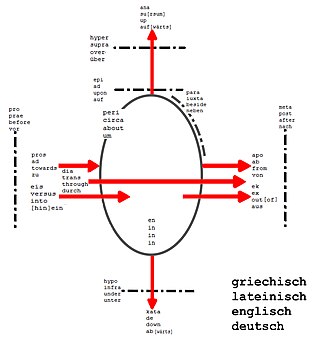
The gigabyte is a multiple of the unit byte for digital information. The prefix giga means 109 in the International System of Units (SI). Therefore, one gigabyte is one billion bytes. The unit symbol for the gigabyte is GB.

A prefix is an affix which is placed before the stem of a word. Particularly in the study of languages, a prefix is also called a preformative, because it alters the form of the word to which it is affixed.

The International System of Units, internationally known by the abbreviation SI, is the modern form of the metric system and the world's most widely used system of measurement. Coordinated by the International Bureau of Weights and Measures it is the only system of measurement with official status in nearly every country in the world, employed in science, technology, industry, and everyday commerce.

The metric system is a decimal-based system of measurement. The current international standard for the metric system is the International System of Units, in which all units can be expressed in terms of seven base units: the metre (m), kilogram (kg), second (s), ampere (A), kelvin (K), mole (mol), and candela (cd). These can be made into larger or smaller units with the use of metric prefixes.

Sumerian was the language of ancient Sumer. It is one of the oldest attested languages, dating back to at least 2900 BC. It is a local language isolate that was spoken in ancient Mesopotamia, in the area that is modern-day Iraq.

The pascal is the unit of pressure in the International System of Units (SI). It is also used to quantify internal pressure, stress, Young's modulus, and ultimate tensile strength. The unit, named after Blaise Pascal, is an SI coherent derived unit defined as one newton per square metre (N/m2). It is also equivalent to 10 barye in the CGS system. Common multiple units of the pascal are the hectopascal, which is equal to one millibar, and the kilopascal, which is equal to one centibar.

Many climbing routes have a grade that reflects the technical difficulty—and in some cases the risks and commitment level—of the route. The first ascensionist can suggest a grade, but it will be amended to reflect the consensus view of subsequent ascents. While many countries with a strong tradition of climbing developed grading systems, a small number of grading systems have become internationally dominant for each type of climbing, which has contributed to the standardization of grades worldwide. Over the years, grades have consistently risen in all forms of climbing, helped by improvements in climbing technique and equipment.

A subnetwork, or subnet, is a logical subdivision of an IP network. The practice of dividing a network into two or more networks is called subnetting.

Mohawk is an Iroquoian language currently spoken by around 3,500 people of the Mohawk nation, located primarily in current or former Haudenosaunee territories, predominately Canada, and to a lesser extent in the United States. The word "Mohawk" is an exonym. In the Mohawk language, the people say that they are from Kanien:ke and that they are Kanienʼkehá꞉ka "People of the Flint Stone Place" or "People of the Flint Nation".
In telecommunications and computing, bit rate is the number of bits that are conveyed or processed per unit of time.
Ni, NI or N-I may refer to:
C is the third letter in the Latin alphabet.
File size is a measure of how much data a computer file contains or, alternately, how much storage it consumes. Typically, file size is expressed in units of measurement based on the byte. By convention, file size units use either a metric prefix or a binary prefix.

Shanghai has an expansive grade-separated highway and expressway network consisting of 16 municipal express roads, 10 provincial-level expressways, and 8 national-level expressways. Three municipal expressways and four provincial-level expressways are also under construction.
This article provides a grammar sketch of the Nawat or Pipil language, an endangered language spoken by the Pipils of western El Salvador and Nicarao people of Nicaragua. It belongs to the Nahua group within the Uto-Aztecan language family. There also exists a brief typological overview of the language that summarizes the language's most salient features of general typological interest in more technical terms.
The Handle System is a proprietary registry assigning persistent identifiers, or handles, to information resources, and for resolving "those handles into the information necessary to locate, access, and otherwise make use of the resources". As with handles used elsewhere in computing, Handle System handles are opaque, and encode no information about the underlying resource, being bound only to metadata regarding the resource. Consequently, the handles are not rendered invalid by changes to the metadata.
00, double zero or variants may refer to:









